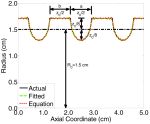EPJ D Highlight - Novel high-power microwave generator
- Details
- Published on 11 February 2015

A new study explores the viability of a novel structure to be used as a component of a high-power microwave source, designed to transfer energy to targets via ultra-high-frequency radio waves
High-power microwaves are frequently used in civil applications, such as radar and communication systems, heating and current drive of plasmas in fusion devices, and acceleration in high-energy linear colliders. They can also be used for military purpose in directed-energy weapons or missile guidance systems. In a new study published in EPJ D, scientists from Bangladesh demonstrate that their proposed novel method, which is capable of producing such microwaves, offers a viable alternative to traditional approaches. The solution was developed by Md. Ghulam Saber and colleagues from the Islamic University of Technology in Gazipur, Bangladesh.
To generate such high-power microwaves, researchers rely on devices referred to as backward wave oscillators, which are designed to transform the energy of an intense electron beam into electromagnetic radiation at microwave frequencies. The electron beam propagates axially through what is referred to as a slow electro-dynamic structure—SWS for short. The latter is designed to slow down the electromagnetic wave to phase velocities less than the speed of light.
Only then can the wave interact with the electron beam in a resonant manner. This interaction, in turn, leads to an instability, which is the prerequisite for energy transfer from the electron beam to the electromagnetic wave, and for turning it into high-power microwaves.
Metallic cylinders with a sinusoidally shaped, periodically corrugated inner wall are being extensively used as SWS. The trouble is that they are difficult to manufacture, and require sophisticated numerical machines to design. To overcome this issue, the authors propose an alternative shape of the SWS, in the form of a novel semi-circular structure. They employ numerical techniques to model the dynamics of this structure, and prove that it is a viable alternative for generating high-power microwaves.
Md. G. Saber, R.H. Sagor and Md. R. Amin (2015), Numerical Study of the Dispersion Characteristics of a Semi-Circularly Corrugated Slow Wave Structure, Eur. Phys. J. D 69: 38, DOI: 10.1140/epjd/e2014-50798-5





